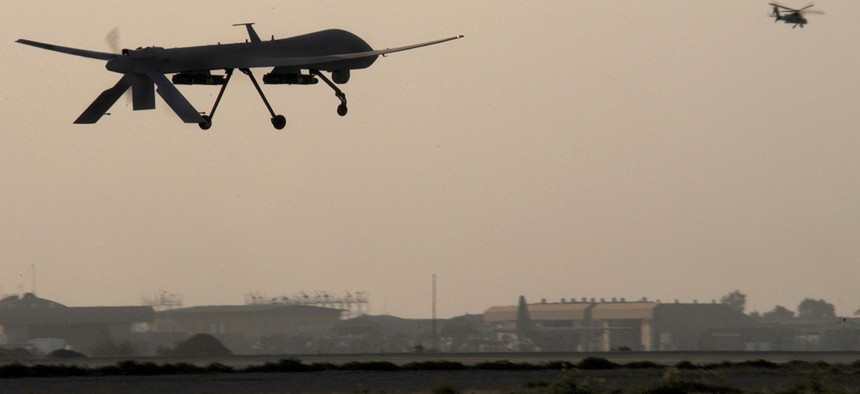
Air Force file photo
Drone Deaths and the Myth of Precision
Civilian casualties are inevitable, but the U.S. appears willing to accept them.
On Thursday morning, President Obama appeared before White House reporters to announce that a January drone strike had inadvertently killed two Western hostages held at an al-Qaeda compound in Pakistan. The tragedy, he said, would lead the United States to review its policy surrounding drone warfare.
"We will identify the lessons that can be learned from this tragedy, and any changes that should be made," he said. "We will do our utmost to ensure it is not repeated."
A day later, however, there's little reason to believe that American policy will change. The existing done program has broad bipartisan support in Congress, reported the National Journal on Friday, and several of President Obama's most outspoken opponents refrained from criticizing the administration.
"We are not going to terminate the drone program," Lindsey Graham, a Republican Senator from South Carolina, said.
The United States has used drone warfare since 2004, but the program escalated since President Obama's inauguration in 2009. For a president eager to wind down America's wars in Iraq and Afghanistan, the small, pilotless aircraft offered an opportunity to target specific enemy combatants without requiring U.S. ground troops.
But drone strikes often aren't as accurate as their proponents claim. The Bureau of Investigative Journalism estimates that the 415 drone strikes launched in Pakistan since 2004 have killed between 2,449 and 3,949 people. Of these, between 400 and 1,000 have been civilians. Micah Zenko, an expert in drone warfare at the Council on Foreign Relations, told The New York Times that of the eight U.S. citizens killed by American drone attacks, seven were killed unintentionally—including Warren Weinstein, one of the two hostages who died in the January strikes.
Technology has improved in the decade-plus since the American drone war began. A second-generation armed drone called the Reaper, for example, canlocate a target to a single room within a house. But drone strikes are only as accurate as the intelligence they're based on. The Obama administration admitted on Thursday that it did not know Weinstein or Giovanni Lo Porto, the Italian aid worker killed alongside him, were in the compound when it was struck in mid-January, despite months of video surveillance. The White House also did not know that Adam Gadahn, a California-born spokesman for al-Qaeda, was present when he died in a separate January drone attack.
Gathering reliable intelligence in the tribal areas of Pakistan, a rugged, remote area largely beyond the federal government's control, remains a formidable challenge. According to a report in Bloomberg, the U.S. is reluctant to send agentsto the area. The nature of al-Qaeda itself—a fluid, stateless organization lacking a clear bureaucracy—makes it difficult for foreign spies to infiltrate. Terror groups have also learned how to minimize use of technology that could betray their location and activities.
Since embracing drone warfare in 2009, the Obama administration has shown a willingness to strike known terrorist targets—even when the possibility of collateral damage exists. The attacks on the compound holding Weinstein and Lo Porto—as well as that on the one holding Gadahn—were deliberate strikes on al-Qaeda targets, little different from hundreds of others launched since 2004. Dan Benjamin, a former State Department officer now at Dartmouth College, toldBloomberg's Josh Rogin that the accidental killing of hostages had simply been a matter of time.
"If you are taking kinetic action against terrorist targets for years and years on end, the law of averages is going to catch up with you and something terrible like this is going to happen," he said.






